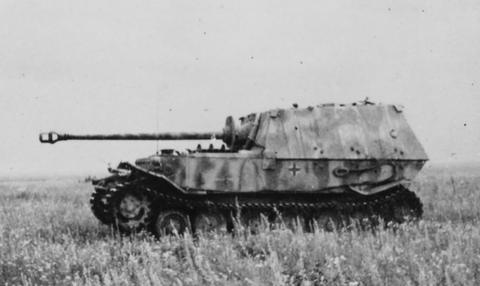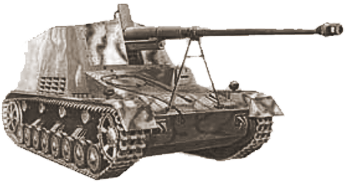The Tarnapol Relief Effort

I have previously written about the circumstances surrounding the Red Army's spring 1944 siege of Tarnapol, as well as a general overview of the siege. Here I would like to delve deeper into the composition of the beseiged garrison, and the German relief effort's operations - using Schwere Panzerjager-Abteilung 653's employment in the relief force to help explain why the Germans failed.
During the March-April 1944 offensive launched by Marshal of the Soviet Union Georgy Zhukov's 1st Ukrainian Front (see the previous article in this series for more) an amalgation of German units caught up in the maelstorm of the Soviet advance found themselves encircled in Tarnapol; the city itself an important communications hub in Galicia. Though there is some disagreement on the exact composition of the enricled German forces most sources agree that the Germans numbered approximately 4,500 men from the following units:
Gren.Rgt.949 & IV./Art.Rgt.359 from 359.Inf.Div.,
Füs.Btl.Demba,
LandesSch.Btl. 543,
Bew.Btl.500
III./SS-Freiw.Rgt.4 - or 3rd Battalion, 4th SS-Volunteer Regiment (Galizien SS Freiwilligen Regiment 4)
Kampfgruppe (KG) Grundmann (company strength)
Alarmkp. W.K. 8.Pz.Div. (Alert Company from elements of the 8th Panzer Division)
Alarmkp. Vogel,
4th Battalion, 359th Artillery Regiment with 3 Batteries
3 x 10.5 cm guns
8 x 15.0 cm guns
1./Stug.Abt.301 (1 x battery of assault guns with 9 assault guns)
1./Pz.Jag.Abt.357 (1 x anti-tank company with 6 guns)
1 x Self-propelled artillery battery of the "LAH" with 6 guns
4./FlakAbt.384 - Elements from 4th Battery, 384th Flak Battalion
There were other minor units as well, all under the command of Major General Egon von Neindorff. In March of 1944 Hitler declared Tarnapol a Fester Platz or "fortress". This meant Neindorff, who had been in command of the city's garrison since late in January 1944, lacked freedom of movement. This ended up being one of the many factors contributing to the garrison's eventual destruction in the face of overwhelming Soviet strength that for the most part was capably deployed, and played the most important role in the German defeat.
Now, one could say that the considerable efforts launched toward saving such a small garrison represented a dubious use of assets - especially when considering the pounding the Germans took in their abortive efforts (the first two in March, the second in April). On the other hand, four and a half thousand men was nothing for the German Ostheer to sneeze at losing during this stage of the war - especially given how undermanned it was. But what is often lost in examining the impact of the German garrison's eventual loss is that most analysts overlook the casualties the 1st Ukrainian Front inflicted on the German relief effort, and the wearing down of what was otherwise a potent armored force that might have been better used elsewhere in lieu of attempting to free a mixed bag of mostly second-tier formations.
To that end let's take a closer look at one of the units that would spearhead the third German relief effort. Early in March the 1st Ukrainian Front had first encircled Tarnapol, but only tenously. The Germans were able to re-establish lines of communication to the city, that is until a renewed push led by the reinforced Soviet 60th Army (including the 4th Guards Tank Corps) cut the Tarnapol garrison off once again on March 23-24th. Then on March 25th a second German relief effort led by a Kampfgruppe organized from elements of the 8th Panzer Division failed shortly after its drive began.
Meanwhile the Russians and Germans were pouring forces into the area. On the German side this included the; 100th Jager-Division, 349th Infantry Division, 367th Infantry Division, 9th SS-Panzer Division, 10th SS-Panzer Division, Schwere Panzer-Abteilung 507, and the majority of Schwere Panzerjäger-Abteilung 653 (minus its 1st company which was fighting in Italy). Several of these formations had recently participated in the relief effort to save 1st Panzer Army (most prominently being the two SS-Panzer Divisions).
Schwere Panzerjager-Abteilung 653 de-trained on April 6, 1944. From there it's two companies of Ferdinand heavy tank destroyers were attached to the 9th SS-Panzer Division. Redesignated the Elefant in May of 1944 the Ferdinand (see the picture accompanying this article) was created in the spring of 1943 from 100 chassis left over from Porsche's failed design for the Tiger I heavy tank. The Ferdinand featured a massively armored superstructure mounting the potent 88m L/71 cannon. This created a monstrous armored fighting vehicles with a combat weight of nearly 70 tons. This meant the Ferdinand was 14 tons heavier than even the much feared Tiger tank. This was in part because the frontal armor reached double the Tiger's thickness, adding over five tons to the vehicle's weight.
The Ferdinand first entered combat at Kursk in July of 1943, and time and again was subsequently proven to be extroardinarily lethal on the battlefield. During the German offensive at Kursk it's crews averaged 10 enemy tanks knocked out for the loss of a single Ferdinand (320 destroyed Soviet tanks to 13 lost Ferdinands). These kill ratio's were even matched or exceeded during subsequent defensive campaigns near Orel in July/August of 1943, and in the Ukraine during the fall of 1943.
The biggest problem with the vehicle however was it's own great size. Mechanical breakdowns plagued the Ferdinands if they were not given frequent and extensive maintenance. In addition they were very difficult to recover. As a result perhaps the best Soviet defense against these armored fighting vehicles (AFV's) ended up being mines. Disabled Ferdinands represented a significant drain on German assets. It often took as many as five German recovery vehicles to get a Ferdinand back to the field repair shops. And Soviet mines could be quite devastating. In one instance the shock of a mine explosion damaged the muzzle brake on a Ferdinand's main gun to such an extant that when the unaware crew fired the cannon it broke loose from it's mount, killing the vehicle's gunner and wounding the commander.
In addition, the weight of the German AFV's meant they lacked the mobility of Soviet T-34's on the muddy spring time roads no less in terms of moving cross-country. Moreover, just battling through the mire placed great strain on the Ferdinand's underpowered engines. In fact and shortly after the final German relief drive began on April 8, 1944 most of the Ferdinands had dropped out of action because their engines had overheated so badly and/or for other mechanical reasons. On the other hand the few Ferdinand's that entered battle performed reasonably well. But so did the Red Army.
By all accounts the Ferdinand's employed in the relief effort enjoyed advantages in kill ratio's over Soviet AFV's. However, please note that Soviet losses have not been accurately tabulated as of the date of this writing. Accordingly, in making this statement I am relying on existing sources claiming that during the relief operation German armor of all types enjoyed a 4:1 kill ratio over the Soviet tanks and assault guns arrayed against them. Nevertheless, the Ferdinands were not invulnerable. One Soviet counter-attack succeeded in destroying two Ferdinands (one hit in the side, the other in the rear, and though both vehicles were recovered the damage was too great to repair). In a preview of what would come during the failed March 1945 German counter-offensive in Hungary heavy Soviet 85mm and 122mm guns used in an anti-tank role played a key role in stopping the big German AFV's. By the time the German relief effort officially was called off on April 18th (Tarnapol was 20km behind Soviet lines, the deepest German penetration covered roughly half that distance) Schwere Panzerjager-Abteilung 653 only had 18 operational Ferdinands of the 31 which it had began the battle (with most of the remainder in maintenance).
As for the 4,500 man German garrison, only 55 would survive a desperate last ditch breakout attempt and make it back to German lines. Moreover, though permanent armor losses were not significant (18 German tanks and self-propelled guns according to most sources) the relief effort suffered a minimum of at least 1,200-1,300 plus casualties (depending on the source), with the 9th-SS Panzer Division (to which Schwere Panzerjager-Abteilung 653 had been attached) bearing the brunt of German casualties. Again Soviet casualties are not accurately known. Point being, even if we take at face value German claims that the local Soviet losses reached 74 tanks and assault guns (and this is doubtful given the Red Army controlled the battlefield and likely returned numerous vehicles to operational status) the entirety of the operation was a significant defeat.
To that end the Red Army must be credited with taking a key road and rail hub that undermined the coheseviness of the Ostheer's defensive lines on a critical axis of the front. Beyond that the German decision to allow the defender's of Tarnapol to be pinned in place, and then mount an expensive relief attempt is simply inexcusable. One can only imagine the damage that could have been caused by two fresh SS Panzer Divisions spearheading a Panzer Corps reinforced with Schwere Panzerjager-Abteilung 653 and the Tiger tank equipped Schwere Panzer-Abteilung 507 all deployed against overextended and worn down Soviet armies fighting in the open.



Post new comment